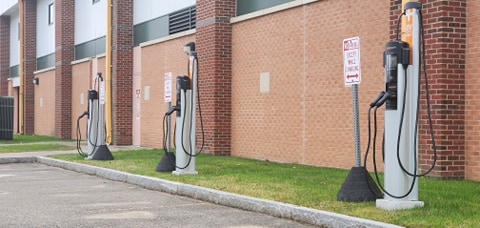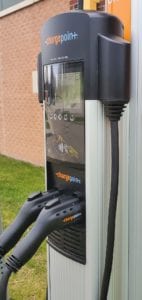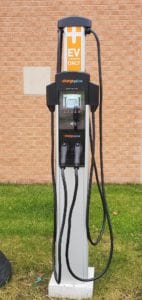Written By: Dominick Matarese

SUNY Broome has installed six electric vehicle charging stations on the north side of the Ice Center. The stations are Type 2, which charge cars at a faster rate compared to a Type 1 station. Six cars can charge at a time, given that there are 3 charging stations with two ports each.
The stations were built through a project developed by students in the new “Clean Energy Design” class (EGR-270). In the class, Robert Lofthouse, Associate Professor/Chairperson of Engineering Science & Physics at SUNY Broome, says “students learn about cutting edge clean energy technologies, and they also learn about our campus energy, how we use energy on campus.” These stations were part of a system where “students in the class develop proposals, improvements we can make to our campus to reduce our greenhouse gas emissions.

The Clean Energy Design Class was newly developed from a $1,000,000 grant from The New York State Energy Research and Development Authority (NYSERDA), to be used to develop “clean energy technologies” on campuses. SUNY Broome was one out of only three schools that were awarded under the Energy to Lead program. The grant also enabled SUNY Broome to build a new geothermal heating and cooling system in the new Calice Advanced Manufacturing Center, as well as a clean energy classroom called the “Sustainability Sandbox.”
Charge Ready NY offers a $4,000 rebate for electric vehicle charging station built in New York. Lofthouse said “students put together [a proposal] where we could buy six charging stations and we would end up getting a $24,000 rebate, which paid for a majority of the cost of the project.”
The charging station project began with a proposal, where students researched how to get a charging station rebate through Charge Ready NY, how much the project would cost, and the optimal location for the charging stations on campus. From there, the project was proposed to the SUNY Broome Sustainability Committee, who approved it and sent it on to the College administration. Eventually, the Grants Committee approved the project and construction began.
The Ice Center was chosen as the location due to its proximity to a strong power source, and so that people could sit in the lounge while they waited for their vehicle to charge. Originally, the stations were slated to be installed early in the spring of 2020, but due to the COVID-19 pandemic, they were not finished until the end of the summer. Now, they are being used daily.
There is a small fee to use a charging station. However, it is much less expensive than it would be to purchase the equivalent amount of gasoline. Lofthouse says “to charge your car it might cost three or four dollars, as opposed to filling up your tank which would cost, for the same amount of gas, five times more at least.” He also said that in the spring, they plan on offering a student and faculty discount to use the stations.
The community can use the “ChargePoint” app. Using the app, drivers with electric vehicles can check to see how many charging points are available and check on how much their car has charged while they are waiting. If coming from a distance away, drivers can use ChargePoint to reserve a station ahead of time.
Lofthouse outlined how the stations are already saving the school both money and greenhouse gas emissions, by saying “so far the data shows, just the little that they’ve been used this spring, we’ve saved 207kg of greenhouse gas emissions” which is equivalent to the carbon absorbed by 5 trees over 10 years. Not only was the grant money used to pay for the charging stations, but the revenue generated by the stations goes into an account that is going to be used for future clean energy projects on campus. Lofthouse says that “by saving energy we can save money, and what we’re trying to do is invest that money back into new clean energy projects which will save even more money.”

On top of cost savings , Lofthouse also touched on how they help the environment, saying; “They also help the greenhouse effect, because if we can produce the electricity in a clean way, it avoids burning the gasoline which causes carbon dioxide to be released in the atmosphere.” He also stressed that “we want to inspire and educate the community about ways that they can make those changes in their own homes and businesses.”
Adam Ruder, Assistant Director of Clean Transportation, NYSERDA said, “Amplifying the number of charging stations on the SUNY Broome Campus helps more students and visitors embrace lowering their carbon footprint. This helps reduce emissions to provide cleaner air and fight climate change, I applaud the Clean Energy Design class, their forward-thinking electric vehicle initiative and investment in clean energy.”
When asked about why he got involved in the eco-friendly side of SUNY Broome, Lofthouse said “I’ve personally always been interested in the environment, and I had a lot of students who really care about helping the planet. Some of the engineering students had come to learn about engineering because they wanted to figure out how to find solutions to our energy needs and our greenhouse gas and global warming problem.”
Other projects completed in the Clean Energy Design class include a window insert in the second floor of the business building to show how much can be saved by adding a second window layer. Students also did a demonstration project where they installed motion sensing and energy efficient LED lighting in the first-floor bathroom of the Applied Technology Building. According to Lofthouse, “students have urged the administration to replace more fluorescent bulbs with LED bulbs.”
The grant also enabled student interns to help with clean energy projects. Some of the student interns “are working on putting a tour around the campus called The Clean Energy Walking Tour where we’ll have posters [about] all the projects around campus to describe how the technology works and how we’re using the technology to save energy and greenhouse gases” says Lofthouse.
Aside from the accomplishments in the Engineering Department, Lofthouse said “the Chemistry Department has been making biodiesel, and they [make] that out of old cooking oil, and they’re able to use that for the bus for the environmental science students to take field trips.”
These projects are just the beginning of how SUNY Broome plans to launch an older, energy inefficient campus, into a new era of energy efficiency and sustainability.

